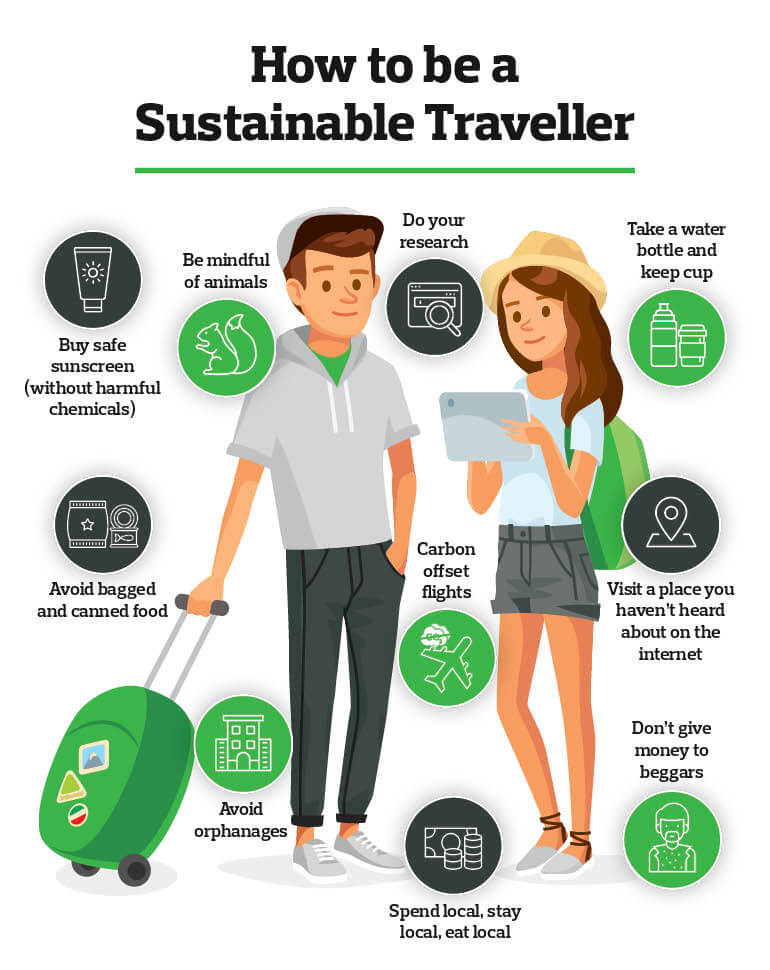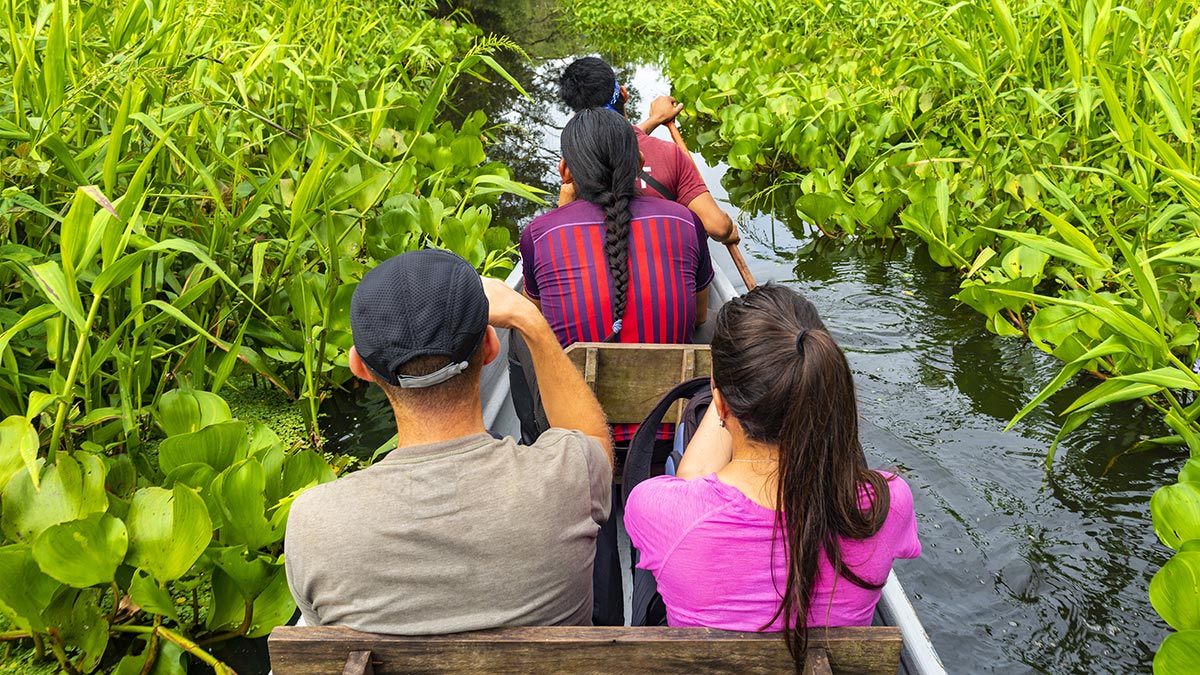Embrace sustainable travel practices by choosing eco-friendly accommodations, reducing your carbon footprint through public transportation or cycling, supporting local economies, and minimizing waste by carrying reusable items.
Traveling Green: 5 Eco-Friendly Practices for a More Sustainable Journey
Sustainable travel is a growing trend in the tourism industry, as more and more people become aware of the impact their travels can have on the environment and local communities. Sustainable travel is all about making conscious choices that minimize negative impacts and maximize positive ones.
It involves reducing your carbon footprint, supporting local economies, and preserving natural and cultural heritage. By choosing to travel sustainably, you can help protect the planet and ensure that future generations can continue to enjoy the beauty and diversity of the world.
One of the key reasons why sustainable travel is so important is its potential to mitigate the negative effects of tourism on the environment.
Traditional tourism can lead to deforestation, pollution, and habitat destruction, all of which can have devastating consequences for local ecosystems and wildlife. By choosing sustainable travel options, such as eco-friendly transportation and accommodations, you can help minimize these impacts and contribute to the preservation of natural resources.
Additionally, sustainable travel can also benefit local communities by providing them with economic opportunities and promoting cultural exchange. By supporting local businesses and engaging in responsible tourism practices, you can help ensure that the benefits of tourism are shared with those who need it most.
1. Choosing Eco-Friendly Transportation Options
When it comes to sustainable travel, transportation is a key consideration. The transportation sector is a major contributor to greenhouse gas emissions, which are a leading cause of climate change. Therefore, choosing eco-friendly transportation options is essential for reducing your carbon footprint while traveling.
One of the best ways to do this is by opting for public transportation, such as buses, trains, and subways, which are more energy-efficient and produce fewer emissions per passenger than private vehicles. In addition to public transportation, walking and cycling are also great sustainable travel options, as they produce zero emissions and allow you to experience your destination in a more intimate and immersive way.
Another eco-friendly transportation option to consider is carpooling or ridesharing. By sharing a ride with others, you can reduce the number of vehicles on the road, which in turn reduces traffic congestion and emissions.
If you do need to rent a car, consider choosing a fuel-efficient or hybrid vehicle, and drive in a fuel-efficient manner to minimize your environmental impact. Additionally, when flying is necessary, consider offsetting your carbon emissions by purchasing carbon offsets, which support projects that reduce greenhouse gas emissions, such as renewable energy or reforestation initiatives.
By making conscious choices about your transportation while traveling, you can significantly reduce your environmental impact and contribute to a more sustainable tourism industry.
2. Packing Light and Mindfully
Packing light and mindfully is another important aspect of sustainable travel. The weight of your luggage directly impacts the fuel consumption of the transportation you use, so packing light can help reduce your carbon footprint.
Additionally, packing light can also make your travels more convenient and enjoyable, as you won’t have to lug around heavy bags or worry about excess baggage fees. When packing for your trip, consider the climate and culture of your destination, and pack versatile clothing and reusable items to minimize waste.
Opt for eco-friendly and sustainable travel products, such as reusable water bottles, shopping bags, and toiletry containers, to reduce your reliance on single-use plastics and disposable items.
Another way to pack mindfully is to consider the environmental impact of the products you bring with you. Choose eco-friendly and biodegradable toiletries, sunscreen, and insect repellent to minimize your impact on the local environment.
Also, consider the souvenirs and gifts you purchase while traveling, and opt for locally-made and sustainable products that support the local economy and culture. By packing light and mindfully, you can reduce your environmental impact, minimize waste, and support sustainable practices while traveling.
3. Supporting Local and Sustainable Accommodations
Choosing accommodations that are both local and sustainable is a key aspect of sustainable travel. By supporting local and sustainable accommodations, you can help minimize the negative impacts of tourism on the environment and local communities, and contribute to the preservation of natural and cultural heritage.
When choosing accommodations, look for eco-friendly hotels, lodges, and guesthouses that have implemented sustainable practices, such as energy and water conservation, waste reduction, and community engagement.
Additionally, consider staying in locally-owned and operated accommodations, as they are more likely to support the local economy and provide authentic cultural experiences.
Another way to support local and sustainable accommodations is by choosing eco-friendly lodging options, such as ecolodges, farm stays, and homestays. These types of accommodations often have a smaller environmental footprint and provide a more immersive and authentic travel experience.
Furthermore, consider the environmental certifications and initiatives of the accommodations you choose, such as LEED certification, Green Key certification, or membership in sustainable tourism organizations. By supporting local and sustainable accommodations, you can help ensure that the benefits of tourism are shared with local communities, and contribute to the preservation of natural and cultural heritage.
4. Minimizing Waste and Plastic Use
Minimizing waste and plastic use is a crucial aspect of sustainable travel. The tourism industry generates a significant amount of waste, including plastic bottles, packaging, and food waste, which can have detrimental effects on the environment and local communities. By making conscious choices about the products you use and the waste you generate while traveling, you can help minimize these impacts and contribute to a more sustainable tourism industry.
One of the best ways to minimize waste and plastic use while traveling is by bringing your own reusable items, such as water bottles, shopping bags, and utensils. By using reusable products, you can reduce your reliance on single-use plastics and disposable items, and minimize the amount of waste you generate.
Another way to minimize waste and plastic use is by supporting businesses and destinations that have implemented sustainable practices, such as waste reduction, recycling, and composting. Look for accommodations, restaurants, and tour operators that have implemented sustainable initiatives, such as plastic-free policies, zero-waste practices, and sustainable packaging.
Additionally, consider the environmental impact of the products you purchase while traveling, and opt for locally-made and sustainable products that minimize waste and support the local economy. By minimizing waste and plastic use while traveling, you can help protect the environment and support sustainable practices in the tourism industry.
5. Exploring Eco-Friendly Activities and Tours
Exploring eco-friendly activities and tours is a great way to experience your destination in a sustainable and responsible manner. Many destinations offer a wide range of eco-friendly and sustainable activities, such as hiking, biking, wildlife watching, and cultural experiences, which allow you to connect with nature and local communities while minimizing your environmental impact.
When choosing activities and tours, look for operators that have implemented sustainable practices, such as wildlife conservation, cultural preservation, and environmental education. Additionally, consider the environmental impact of the activities you choose, and opt for low-impact and responsible options that support the preservation of natural and cultural heritage.
Another way to explore eco-friendly activities and tours is by supporting local and community-based initiatives, such as ecotourism projects, community tourism programs, and sustainable tourism organizations.
These types of activities and tours often provide authentic and immersive travel experiences, while also supporting the local economy and preserving natural and cultural heritage. Additionally, consider the environmental certifications and initiatives of the operators you choose, such as eco-labels, responsible tourism certifications, and membership in sustainable tourism organizations.
By exploring eco-friendly activities and tours, you can help minimize your environmental impact, support local communities, and contribute to the preservation of natural and cultural heritage.
6. Eating Sustainably on the Road
Eating sustainably on the road is an important aspect of sustainable travel. The food and beverage industry can have a significant impact on the environment and local communities, so making conscious choices about the food you consume while traveling is essential for reducing your environmental footprint. One of the best ways to eat sustainably on the road is by supporting local and organic food producers, such as farmers markets, food cooperatives, and farm-to-table restaurants. By choosing locally-sourced and organic foods, you can support the local economy, reduce the carbon footprint of your meals, and enjoy fresh and healthy cuisine.
Another way to eat sustainably on the road is by minimizing food waste and supporting sustainable dining practices. Choose restaurants and eateries that have implemented sustainable initiatives, such as waste reduction, composting, and sustainable sourcing. Additionally, consider the environmental impact of the foods you consume, and opt for plant-based and sustainable options that minimize your carbon footprint and support ethical and responsible food production. By eating sustainably on the road, you can help minimize your environmental impact, support local food producers, and contribute to a more sustainable food and beverage industry.
7. Engaging in Responsible Wildlife Tourism
Engaging in responsible wildlife tourism is a crucial aspect of sustainable travel. Wildlife tourism can have both positive and negative impacts on the environment and local communities, so making conscious choices about the wildlife experiences you participate in is essential for minimizing negative impacts and supporting conservation efforts.
When engaging in wildlife tourism, choose operators and experiences that have implemented responsible and sustainable practices, such as wildlife conservation, ethical animal encounters, and environmental education. Additionally, consider the environmental impact of the wildlife experiences you choose, and opt for low-impact and responsible options that support the preservation of natural habitats and wildlife.
Another way to engage in responsible wildlife tourism is by supporting conservation initiatives and ethical wildlife sanctuaries. Many destinations offer opportunities to support wildlife conservation efforts, such as volunteering, donating, and participating in educational programs.
By supporting these initiatives, you can contribute to the preservation of natural habitats and wildlife, and help ensure that future generations can continue to enjoy the beauty and diversity of the natural world.
Additionally, consider the environmental certifications and initiatives of the wildlife operators you choose, such as wildlife-friendly certifications, responsible wildlife tourism guidelines, and membership in conservation organizations. By engaging in responsible wildlife tourism, you can help minimize negative impacts, support conservation efforts, and contribute to a more sustainable wildlife tourism industry.
8. Offsetting Your Carbon Footprint
Offsetting your carbon footprint is a great way to mitigate the environmental impact of your travels and contribute to the preservation of natural resources. Carbon offsetting involves supporting projects that reduce greenhouse gas emissions, such as renewable energy, energy efficiency, and reforestation initiatives, to compensate for the emissions produced by your travels.
Many airlines and travel companies offer carbon offset programs, which allow you to calculate the emissions of your trip and purchase offsets to support sustainable projects.
Additionally, there are many independent organizations and initiatives that offer carbon offset options, which allow you to support specific projects and contribute to a more sustainable future.
Another way to offset your carbon footprint is by making conscious choices about your energy consumption and supporting renewable energy initiatives.
Consider the environmental impact of the accommodations you choose, and opt for eco-friendly and energy-efficient options that minimize your carbon footprint. Additionally, consider the environmental impact of the transportation you use, and choose low-impact and energy-efficient options, such as public transportation, walking, and cycling. By offsetting your carbon footprint, you can help mitigate the environmental impact of your travels, support sustainable projects, and contribute to a more sustainable tourism industry.
9. Spreading Awareness and Encouraging Others to Travel Green
Spreading awareness and encouraging others to travel green is a key aspect of sustainable travel. By sharing your experiences and knowledge about sustainable travel practices, you can inspire others to make conscious choices about their travels and contribute to a more sustainable tourism industry.
One of the best ways to spread awareness is by sharing your sustainable travel experiences on social media, blogs, and travel forums, and encouraging others to make conscious choices about their travels.
Additionally, consider the environmental impact of the products you purchase while traveling, and opt for locally-made and sustainable products that minimize waste and support the local economy. By spreading awareness and encouraging others to travel green, you can help protect the environment and support sustainable practices in the tourism industry.
Another way to spread awareness and encourage others to travel green is by supporting and participating in sustainable tourism initiatives and campaigns. Many organizations and initiatives offer opportunities to support sustainable tourism practices, such as volunteering, donating, and participating in educational programs.
By supporting these initiatives, you can contribute to the preservation of natural resources and cultural heritage, and help ensure that future generations can continue to enjoy the beauty and diversity of the world.
Additionally, consider the environmental certifications and initiatives of the organizations you support, such as sustainable tourism certifications, responsible tourism guidelines, and membership in conservation organizations. By spreading awareness and encouraging others to travel green, you can help minimize negative impacts, support conservation efforts, and contribute to a more sustainable tourism industry.
Conclusion
In conclusion, sustainable travel is all about making conscious choices that minimize negative impacts and maximize positive ones.
Sustainable travel is not only important for reducing your environmental impact, but also for supporting local economies, preserving natural and cultural heritage, and promoting responsible tourism practices.
By making conscious choices about your travels, you can contribute to a more sustainable tourism industry and help create a more sustainable future for the planet.





Leave a Reply